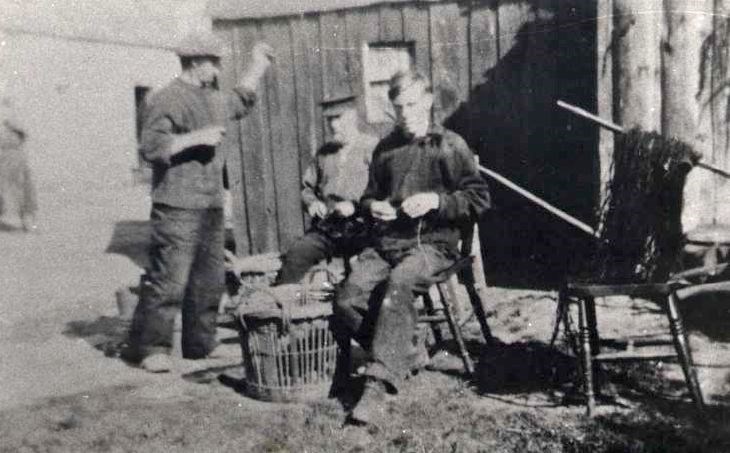
Fishermen baiting lines
Date Added: 25 September 2008
Year: 1900
Institution Name: dnhhl
Cat No: ◀ | 2005_042_04 | ▶
Picture No: 4907
Monochrome photograph of group of three fishermen baiting lines from the collection of Dennis Bethune
Dimensions: Length 129mm - Width 80mm
1 Comment
Form Goes Here
In my childhood many Embo men and boys set long lines along the sand beach between Embo and Loch Fleet. Many of these lines had up to 500 hooks which were baited mostly with lugworm or sand eels but sometimes with cockles or mussels. The main line was a sturdy string made from hemp or similar natural material while the traces (Cheepighs – sp? in Gaelic)were made of several strands of twisted horse hair. The lines were secured to the sea floor by the use of iron stakes or large stones. Care had to be taken in the spacing of the traces so as to ensure that neighbouring hooks did not foul each other. The lines were set at low tide and then collected at the following low tide. The lines had to be checked well before full low tide and all fish removed before the hooked fish were stolen by sea gulls or other sea birds. The fish that were caught were mostly flounders but I have on occasion seen decent sized sea trout being caught. Most of these baits were sourced from the sand flats on the South shore of Loch fleet at low tide. Sand eels (Sachasan in Gaelic) were much sought after and at certain times of the year large numbers of them were caught in the sand at the Embo side of the loch’s mouth. Sand eels only moved in a certain type of “friable†sand and they were caught by swiftly digging in the sand with a “Caib†after a shoal had been detected. Most people had their own “Caib†which was a dedicated tool specially made for sand eel catching. It had a short and thick wooden shaft which was fitted into the head which was an iron horse shoe sharpened on the leading face. An experienced sand eel hunter could fill a pail in minutes if he found a sizable shoal. When lug worms (Lugaith in Gaelic) were being collected a conventional garden spade was used. They were plentiful in the muddy tidal sands in the area known as the “Ajhal†near the Skelbo rail crossing house where the MacLachlan family then lived.
I have been back to the Embo area several times over the years. Sometimes I hankered after a boiling of cockles or mussels from the shore of Loch Fleet. This served with a garlic, sweet basil and butter dressing and not the teaspoon of salt we used in Embo! However when I contacted the relevant environmental protection officer in Golspie prior to the visits I was told in no uncertain terms that this was not possible. Having been a policeman in Africa for 43 years and fully familiar with the hunting and food gathering rights of indigenous peoples in their home tribal areas I tried to play that card but I still met with no success. So I had to revert to what the Afrikaans people here in South Africa do in such situations... 'n Boer maak 'n plan.
Comment left on 06 November 2010 at 23:12 by Kenneth Mackay